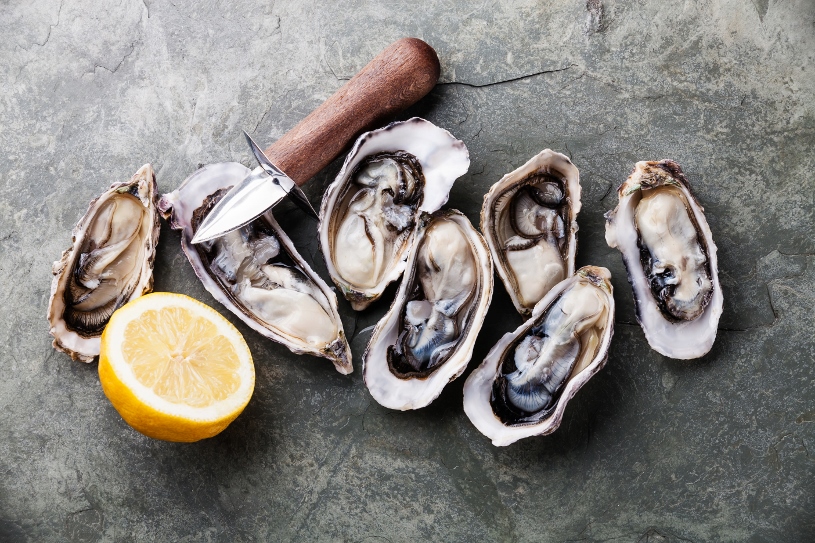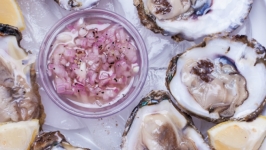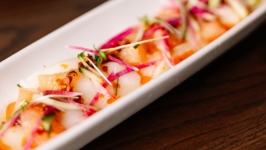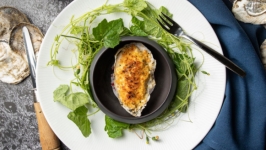Oysters 101: Five Tips from an Oyster Expert
Try these tips to get the most enjoyment from your oysters!
We’re still in the glorious “r” months (from September through April), the traditional season to enjoy the silky brine of Chesapeake oysters on the half shell. Harvested locally, shucked fresh and served up raw, oysters represent a culinary Chesapeake tradition that’s been around as long as people have lived in the watershed.
There’s been a sea change of sorts, however, for Chesapeake oysters in the last decade. Native oyster populations were suffering the catastrophic impacts of disease in the 1980s and '90s, and as a result, Virginia and Maryland embraced two new initiatives to aid the dwindling stocks: intensive oyster farming and oyster sanctuaries.
Particularly for oyster lovers, oyster farms have transformed the selection of oysters available at your local raw bar. Where you used to be able to order only “local Chesapeakes” and pretty much know what you were getting, today the choices for consumers can be overwhelming. Do you want wild or farmed? Virginia or Maryland? Sweet or salty? Local divers or just locally caught?
Navigating the menu in this new world of oysters can be fun—and tasty— once you understand the lingo. Here are five pointers to quickly get you slurping like a true connoisseur.
1. LOCAL
This term is pretty broad. ‘Local’ can mean anything from “caught 300 yards from the restaurant” to “caught 50 miles away.” Want to get a bead on where your bivalves came from? Ask for the tag. All shellfish sold in the United States has to be tagged to identify when and where it was caught. Location is important because oysters will often taste quite different depending on where they were harvested in the Bay. Upper Bay oysters are sweeter, mid-Bay are complex with a note of salt, and low Bay oysters can be very salty—so “local” matters!
2. WILD VS. DIVERS
Wild oysters are a native, naturally-occurring oyster species, Crassostrea virginica, that are caught by watermen who employ a few methods to harvest them— mainly dredges (triangular rakes with nets dragged behind oystering boats) or tongs (scissor-like rakes used by hand or with a mechanized system to harvest oysters). ‘Diver’ oysters are the same kind of oyster—just harvested by a small population of actual divers in wetsuits, who swim down to pluck each oyster individually from the Bay’s bottom.
3. FARMED
Unlike many fish species, which are lower in quality and sources of significant pollution when farmed, oysters are actually good for the environment, sustainable, and in some cases even better when cultivated on an oyster farm. Just like wild oysters, farmed oysters are the same Chesapeake native species. Most are sterile, known as “triploids,” which makes them more resistant to disease and faster growing. Most oyster farmers specifically raise their oysters for the half-shell market, so they have deeper reservoirs, or ‘cups,’ in order to reserve all the precious liquor inside. Farmed oysters also have a consistent flavor—something that isn’t true of wild oysters, which are harvested wherever available and might be salty, sweet, or somewhere in between, depending on where they were caught.
4. TO CONDIMENT OR NOT TO CONDIMENT
The best rule of thumb is to taste your first oyster without any cocktail or hot sauce. Know what you’re getting. A fresh oyster should smell like the ocean, and should be shucked and served immediately so that the delicate flavor and liquor is preserved. Condiments can mask that— and can hide a variety of sins. So, eat your first oyster naked. Anything to follow is fair game for lemons, cocktail sauce, Tabasco, or any other favored fillips.
5. FRESHNESS, THE MOST IMPORTANT RULE
Oysters should be fresh—the fresher, the better. It doesn’t matter how local they are—if they were harvested a week ago, or were shucked and sitting out for hours in advance, they are much worse than an oyster harvested yesterday on the other side of the country. Two ways to deal with this: either shuck your oysters yourself or make sure your oysters are shucked in front of you (many raw bars are out in the open just for this reason), and when in doubt, ask to see the shellfish tag that will tell you not only where but how recently your oysters were harvested.










